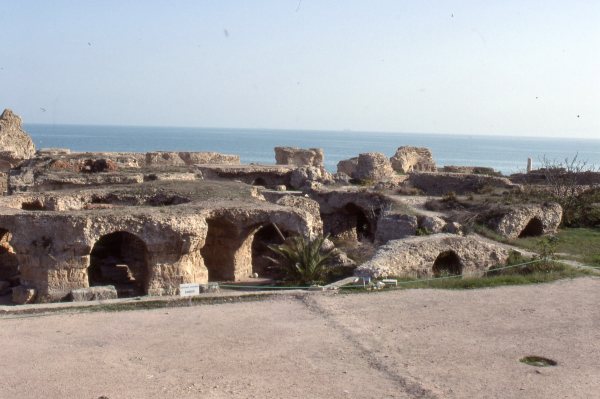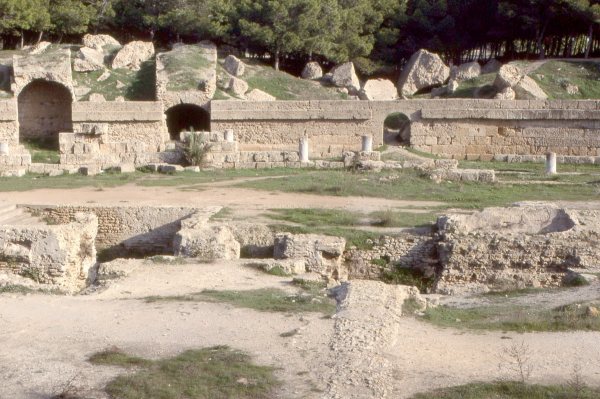Far from the commercialism of Tunis City, in a forgotten quiet glade away from the crowds, several small statues forming Le Tophet rise from a dip in the earth.
1) Le Tophet: photo from Wikipedia
These unassuming relics are virtually the only remnant of the great Phoenician civilization which had its capital at Carthage. Regrettably the statues’ provenance is not pleasant. The stones crudely depict child sacrifice, a ritual around the ancient Middle East that was practiced often enough, mostly in times of crisis. The Phoenicians, those great navigators and civilizers of the Mediterranean, Europe, and Africa, were not immune to the call of blood.
The Romans put an end to the Phoenician culture. Such was the ferocity of the the hatred that they razed Carthage to the ground, salted the very dirt under its center, and built their own city on the wreckage.
1) Roman ruins at Carthage
I once camped for a couple of weeks in the modern Tunis suburb of La Goulette . Perhaps the most urban campground I have ever frequented, it was located on a dirty beach that overlooked the Tunis Roads and port and was just a kilometer or so from Carthage. The place was a maze of tents and encampments enclosed on either side by stone jetties. Big ships waited offshore for their chance to offload their cargoes in the port and the ocean was not particularly clean.
2) Port of Tunis near La Goulette
Here gathered a mixed collection of travelers. Some waited for boats to Sicily. Others, like myself, fielded the bureaucracy of the local Libyan embassy, attempting to obtain permission to travel in the land of Ghaddafi.
But the complex of Roman architecture nearby at Carthage was inspiring in itself.
3) Ancient beachfront foundations near the campground
I would spend afternoons clambering around the ruins with new friends, searching for evidence that the Phoenicians had once inhabited the area. The Romans, however, did a splendid job of destruction and eliminated all traces of their enemies with the exception of the Tophet. Hard to understand the reasoning, if indeed there was any.
4) Roman arena
I only ventured into Tunis on official business. The unfriendly staff at the Libyan embassy first said I had to have my passport translated into Arabic before they would consider issuing a visa. This was part of the Libyan program to wipe any trace of European colonialism from their day-to-day life. Despite the fact that the officials I spoke with spoke good English, the country had taken great impractical steps to pretend that European languages no longer existed. Thus my passport, written only in English and French, was not sufficiently communicative to allow entry into their country.
I went to the Canadian embassy to have my passport reworked. They were helpful, but the kind woman who transcribed my information into written Arabic was functionally illiterate in the language of Mohamed, and the Libyans were unable to read her scribbles.
The actual city of Tunis came as a rude shock after my months in remote North African deserts. Highly Europeanized, it felt trashy, fake, and kitsch.
5) Touristic goofiness in Tunis
What passed for the old quarter was overrun with tour groups seeking fashionable yet gaudy local textiles and other meaningless trinkets. I barely saw the beauty of the seaside city.
6) Old and new in Tunis
So La Goulette became a refuge from my battles with the Libyans and Canadians. I wasn’t sure which of the two parties was less understanding of the realities of travel.
7) Scenery at Carthage
But the campground contained its hazards. One day, while talking with a French guy beside my sleeping bag – I didn’t possess a tent and left my gear loosely on the beach beside a circle of fire stones – several policemen charged onto the beach. They ran directly to a tent not far away and pulled out another Frenchman, taking him away in handcuffs. I later learned that he had been sampling the local male talent in his tent and affronted somebody or other who called the cops.
I departed Tunis and La Goulette finally, catching a flight to Tripoli. I’d discovered that the border between Libya and Egypt was closed down and everyone who was headed East had to fly on to Cairo.
So Carthage days became just another memory.








